In the first of an ongoing series of diverse and wide-ranging collections called Archive Masters, Radio Archives brings you ten hours of entertainment from ten different radio series. It’s a panorama of what radio was like in its prime -- featuring the unique comedy of “Easy Aces” and Bob and Ray, dramatic shows starring Charles Boyer, Robert Cummings, and Rosalind Russell, two innovative plays written by radio’s “poet laureate,” Norman Corwin, domestic comedy with “Mr. & Mrs. Blandings” starring Cary Grant and Betsy Drake, rural quizzes and contests with “The Man on the Farm,” Arlene Francis arranging an evening on the town between servicemen and beautiful models on “Blind Date,” newspaper reporter Randy Stone uncovering ‘the human side of the news’ on the “Night Beat,” and popular singing star James Melton appearing in two mid-1940s rebroadcasts of “The Texaco Star Theater.”
Columbia Presents Corwin
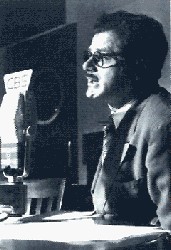 There is very little that can be written about Norman Corwin that has not already been better expressed by others. That he is an outstanding writer and was an innovative force in radio is indisputable; given carte blanche treatment by his employers, the Columbia Broadcasting System, he wrote, produced, and directed many of the most memorable programs ever to be heard on the public airwaves. Working in tandem with the most talented actors and actresses of his time, he created programs that set new standards for what radio was -- and, more importantly, what it could be.
There is very little that can be written about Norman Corwin that has not already been better expressed by others. That he is an outstanding writer and was an innovative force in radio is indisputable; given carte blanche treatment by his employers, the Columbia Broadcasting System, he wrote, produced, and directed many of the most memorable programs ever to be heard on the public airwaves. Working in tandem with the most talented actors and actresses of his time, he created programs that set new standards for what radio was -- and, more importantly, what it could be.
In the summer of 1945, CBS offered him an eight-week series in which would be presented a combination of new works, as well as a restaging of some earlier plays that had received significant public acclaim. The two programs offered here reflect the latter -- and, hearing them today, it’s understandable that there was a desire for them to be heard once again by the 1945 audiences that had enjoyed them earlier that decade. Take note particularly of the use Corwin makes of evocative musical scores to highlight both the drama and panoramic sweep of these two shows; Lyn Murray’s score for “Daybreak” is as much the star of the show as is Ronald Colman and, in “Savage Encounter,” we get a taste of the broad but under-appreciated talents of Harry Simeone -- best remembered today for his classic choral recording of “The Little Drummer Boy.”
Both of these programs were digitally preserved from 16” CBS/KNX copy discs, recorded directly from the network reference recordings by Radio Recorders in Hollywood.
Daybreak (#2 of 8)
In a truly poetic and wonderfully creative use of radio, Ronald Colman gives a bravura performance narrating the progress of daybreak on a typical day, following the sunrise from the middle of the Atlantic Ocean all the way around the world. An authentic masterpiece, highlighted by an outstanding score by Lyn Murray as conducted by Lud Gluskin, the program was written, produced, and directed by Norman Corwin and features unique vocal solos by Corina Mura.
Tuesday, July 10, 1945 - 30:00 - CBS, sustaining
Savage Encounter (#6 of 8)
Glenn Ford stars as a fighter pilot who, having bailed out of his plane over the Pacific Ocean, finds himself stranded on a remote and uncharted island. Inhabited by a race of peaceful people and led by an elderly white man, the pilot feels he has discovered a paradise - but, after speaking at length of the war in the outside world, soon finds himself on trial for his life out of fear that the savagery of his influence might contaminate the serenity of the island. Featuring a score by Harry Simeone, conducted by Lud Gluskin, the script was previously aired on March 28, 1944 and is written, produced, and directed by Norman Corwin.
Tuesday, August 7, 1945 - 30:00 - CBS, sustaining
Presenting Charles Boyer
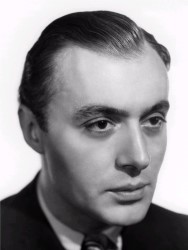 Beginning as a mid-summer replacement series for “Fibber McGee and Molly” in July of 1950, “Presenting Charles Boyer” offered its romantic leading man the chance to portray on radio the same sort of charming character that had earlier brought him to prominence in the movies: a French rogue named Michel -- handsome, clever, and usually broke, but with a continental style and demeanor that could melt the coldest young female heart. Based on characters created by Ernest Vadja and Clement Scott Gilbert, the series also starred Hanley Stafford as an American magazine writer named Bart Conway. Based in Paris, Conway is always in need of a good story to write up and send to his publishers. Since Michel always has both a good story to tell and an ongoing need for pocket money, Conway is happy to pay him $200.00 (plus his dinner check) in exchange for a saleable tale.
Beginning as a mid-summer replacement series for “Fibber McGee and Molly” in July of 1950, “Presenting Charles Boyer” offered its romantic leading man the chance to portray on radio the same sort of charming character that had earlier brought him to prominence in the movies: a French rogue named Michel -- handsome, clever, and usually broke, but with a continental style and demeanor that could melt the coldest young female heart. Based on characters created by Ernest Vadja and Clement Scott Gilbert, the series also starred Hanley Stafford as an American magazine writer named Bart Conway. Based in Paris, Conway is always in need of a good story to write up and send to his publishers. Since Michel always has both a good story to tell and an ongoing need for pocket money, Conway is happy to pay him $200.00 (plus his dinner check) in exchange for a saleable tale.
“Presenting Charles Boyer” had a limited run of only four months - July thru October 1950 - and, curiously, never attracted a sponsor. This is a real shame, as the series was clearly well crafted and Boyer had a voice and a presence that made him perfect for the intimacy of radio. But no matter -- at least we have recordings of the programs to hear and enjoy today, including the first two consecutive shows of the series, offered here as digitally preserved from 16” NBC Orthacoustic lacquer copy discs. In particular, be sure to hear the broadcast of July 11, when we get our first glimpse into the kind of dramatic depth the series might have pursued had it survived a little longer on the air.
Adventure with a Slide Rule Blonde
Michel recalls an encounter with a beautiful blonde in a Monte Carlo casino -- beautiful, and very intelligent, too. So intelligent, in fact, that with the use of a slide rule and a series of advanced probability theorems, she’s able to win again and again at roulette! Mary Jane Croft co-stars in a light-hearted program that was written by Robert E. Lee and directed by Nat Wolff; also in the cast are Jack Edwards, Herbert Butterfield, Fritz Feld, Paul Marion, Veola Vonn, and announcer Don Stanley.
Tuesday, July 4, 1950 - 30:00 - NBC, sustaining
The Thief, a Beautiful Woman, and My Life of Crime
In a touching entry in the series, a bowl of pansies reminds Michel of his brief period as a pickpocket, working under the expert guidance of his old friend Fingers, played by Sheldon Leonard. His life of crime is cut short, though, when he accidentally steals the purse of a woman -- then, while reviewing the contents, discovers the tragic secret she has revealed to no one. Written by Leonard St. Clair and directed by Nat Wolff, the program features Betty Moran, Herb Butterfield, Jane Morgan, Jeffrey Silver, Veola Vonn, Rolfe Sedan, and announcer Don Stanley.
Tuesday, July 11, 1950 - 30:00 - NBC, sustaining
Mr. & Mrs. Blandings
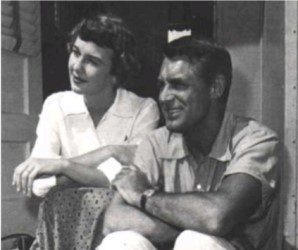 Real-life married couple Cary Grant and Betsy Drake star in “Mr. and Mrs. Blandings,” a radio situation comedy based on books by Eric Hodgins and on the 1948 RKO-Radio Pictures film, “Mr. Blandings Builds His Dream House.” A cut above the standard radio sit-com of the time, this well-written and equally well-acted series tells the tale of Jim and Muriel Blandings, a married couple in their mid-30’s who, tiring of the cramped surroundings of their New York apartment, decide to buy and renovate a 150-year-old home in the country. Aided by their friend Bill Cole (Gale Gordon), a smart and practical attorney who also happens to be a former beau of Mrs. Blandings, their misadventures dealing with the joys and sorrows of endless home maintenance, parenthood, neighbors, and commuting to and from the city form the basis for a very entertaining series of shows.
Real-life married couple Cary Grant and Betsy Drake star in “Mr. and Mrs. Blandings,” a radio situation comedy based on books by Eric Hodgins and on the 1948 RKO-Radio Pictures film, “Mr. Blandings Builds His Dream House.” A cut above the standard radio sit-com of the time, this well-written and equally well-acted series tells the tale of Jim and Muriel Blandings, a married couple in their mid-30’s who, tiring of the cramped surroundings of their New York apartment, decide to buy and renovate a 150-year-old home in the country. Aided by their friend Bill Cole (Gale Gordon), a smart and practical attorney who also happens to be a former beau of Mrs. Blandings, their misadventures dealing with the joys and sorrows of endless home maintenance, parenthood, neighbors, and commuting to and from the city form the basis for a very entertaining series of shows.
Taken from 16” NBC transcriptions, these programs may seem slightly dated today - imagine a four-bedroom, fully restored home in the country costing just $35,000.00 - but the charm and talent of both the creators and the leading actors make them, in many ways, just as enjoyable and entertaining today as they were well over fifty years ago.
Jim’s Television Appearance
Jim is entirely opposed to television so, when Muriel has one installed in their home, Jim insists that it be immediately returned to the store. However, when Bill Cole calls at the last minute to ask Jim to stand in for him on a TV panel show, Jim is upset that Muriel won’t have a set on which to see his appearance. Featured in the cast are Gail Bonney, Gene Bates, Marion Richmond, Ed Max, Jerry Hausner, and Earl Keene. The program is written by M. Winkel (the pseudonym of series co-star Betsy Drake), directed by Warren Lewis, and Don Stanley is the announcer.
Sunday, February 25, 1951 - 30:00 - NBC, sponsored by Trans-World Airlines
Selling the House
After a week’s worth of unexpected household maintenance expenses, Jim is fed up and decides to sell the house. He soon reconsiders -- but he may be too late, as a flashy and moneyed couple from New York are on their way this evening to look over the property and, if they like it, buy it on the spot. Featuring hilarious guest appearances by Sandra Gould and Sheldon Leonard as the prospective buyers, the program also features Jim Backus as Mr. Martin, the unscrupulous real estate agent, and Dick Ryan as Mr. Jenkins, the handyman. The program is written by Charles Stewart and Mort Lachmann, directed by Warren Lewis, and Don Stanley is the announcer.
Sunday, March 18, 1951 - 30:00 - NBC, sponsored by Trans-World Airlines
Blind Date
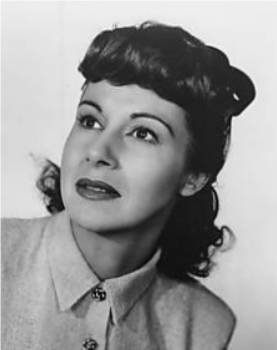
The premise was quite simple: bring together six clean-cut servicemen, gathered from entertainment industry-sponsored nightspots like the Stage Door Canteen, hire three beautiful models or aspiring actresses willing to go on a chaperoned date with one of them, then have hostess Arlene Francis assist the servicemen in convincing one of the women to go out with them on a “blind date.” Sound familiar? Fans of the 1960s and 1970s television show “The Dating Game” might think so -- and well they should, since this radio and early television stalwart formed the basis for that later concept.
Arlene Francis came to New York as an aspiring actress in the early 1930s. Known among producers as “Radio’s Oomph Girl” for her unflagging vitality and charm, she made the rounds of the daytime network programs, appeared frequently (if anonymously) on the popular “March of Time” series, and eventually found a long-term niche as a soap opera heroine on such dramas as “Betty and Bob” and “Central City.” In addition, in 1936, she began a long-term contract as the sophisticated, articulate, and sexy-voiced hostess of “The Hour of Charm” starring the popular Phil Spitalny and his All-Girl Orchestra. Despite her initial desire to become a stage actress, she soon realized that radio could not only provide her with a steady income, but also be the basis for the kind of stable stay-at-home lifestyle she wanted for herself -- particularly after she divorced first husband Neil Agnew and married Martin Gabel, himself an extremely successful radio and stage actor.
Throughout the 1940s, she would appear occasionally in Broadway plays, but the bulk of her time was devoted to numerous appearances on New York-based dramatic programs such as “The Cavalcade of America,” “The Mercury Theater” and “The Campbell Playhouse” - both with Orson Welles - and, in July of 1943, as the hostess of “Blind Date,” Beginning as an NBC summer replacement series for the popular “Frank Morgan-Fannie Brice Show,” the simplicity and good-hearted patriotism of “Blind Date” soon captured the fancy of the nation. Moving to the fledgling Blue Network (ABC) in October of that year, Arlene Francis weekly demonstrated her talent for entertaining an audience, as well as her growing ability to humorously ad-lib her way out of most any situation -- a skill necessary for anyone hosting an unscripted and unpredictable audience participation show. The show outlasted the war -- but only just, ending its run in January of the following year.
Listeners raised in today’s more permissive times might find “Blind Date” to be rather innocent and naive, at least compared to the current trend in more graphic reality-type dating shows. There’s no doubt that the attitudes and mores of the 1940s were far different than those of the new millennium -- but that doesn’t mean that the “Blind Date” radio series has lost any of its ability to charm or entertain modern audiences. These two programs, transferred from recently discovered 16” lacquer linechecks and unheard since their original airings, show America during a time of change; with a long and hard-fought world war drawing to a close and a new peacetime society yet to be established, many a young man wanted nothing more than a shave, a hot shower, a change of clothes, and a chance to spend a memorable evening on the town with a beautiful young woman.
Come to think of it, perhaps times haven’t changed all that much...
Guest Chaperone Glenda Farrell
Broadcasting from New York City, a paratrooper and a ship’s cook vie for a date with an aspiring actress, an Army private and a Navy musician try to make a date with a radio actress, and a PFC paratrooper and another Navy musician compete for an evening out with a New York actress and model. The winners receive dinner at the Stork Club, tickets to the Broadway musical “Marinka” and also tickets to the new 20th Century Fox Technicolor musical “State Fair.” Teddy Rath conducts the orchestra and Ken Roberts is the announcer.
Friday, August 31, 1945 - 8:00-8:30 PM - 30:00 - ABC, sponsored by Etiquette Deodorant and Hinds Hand Cream
Guest Chaperone Hazel Brooks
Broadcasting from New York City, a Marine private and a Coast Guard radar man vie for a date with an American Airlines stewardess, a Navy sonar man and an Army corporal try to make a date with a dark-haired beauty from Syracuse, and an Army PFC and a Navy coxman compete to date another stewardess. The winners receive dinner at the Stork Club, tickets to the Broadway musical “Marinka” and also tickets to the film “Duffy’s Tavern.” Teddy Rath conducts the orchestra and Ken Roberts is the announcer.
Friday. September 28, 1945- 8:00-8:30 PM - 30:00 - ABC (WJZ New York aircheck), sponsored by Pebeco Toothpaste and Hinds Hand Cream
Four Star Playhouse
As a response to the 1948 CBS raid on NBC’s talent pool, NBC chose to develop a number of series featuring top Hollywood stars. In mid-1949, the network hired Robert Cummings, Fred MacMurray, Loretta Young, and Rosalind Russell to appear in rotation as the leads in a new anthology series titled “Four Star Playhouse.” Offering stories from the pages of Cosmopolitan Magazine, as adapted for radio by Milton Geiger, the series ran the gamut from suspense to farce to melodrama to thriller -- and, sadly, lasted just three months. Seems it was just too similar to other movie star-based dramatic programs that were running on the networks and in syndication around the same time.
However, this limited run doesn’t mean the programs weren’t entertaining or worth hearing today -- quite the contrary. The featured stars of the two shows offered here, Bob Cummings and Rosalind Russell, had previously proven themselves to be highly capable radio performers -- and, supported by top radio talent, they give today’s listeners an entertaining glimpse into not only their unique broadcast talents, but also into a network in transition, desperate to regain its dominance in the industry. These two shows were digitally preserved directly from 16” NBC Orthacoustic lacquer copy discs, transferred from the network linecheck reference recordings in 1951, and offer outstanding fidelity.
The Hunted
Robert Cummings, Lurene Tuttle, and William Conrad star in a tense story about a man named Fred Woodard, new in town, who comes to the aid of a young lady being followed by a mysterious man with a white scarf around his neck. Fred soon finds himself mixed up in a web of deception, theft, madness -- and murder. Based on the Cosmopolitan Magazine short story by Maurice Beaudine Jr. and adapted for radio by Milton Geiger, the program is directed by Warren Lewis, with music composed and conducted by Albert Harris; also featured in the cast are Wilms Herbert, Lawrence Dobkin, and announcer Edward King.
Sunday, August 14, 1949 - 30:00 - NBC, sustaining
The Incredible Anna Lee
This farcical comedy about an enthusiastic and overly dramatic Hollywood movie star and her long-suffering publicist stars Rosalind Russell and Frank Lovejoy. Based on the Cosmopolitan Magazine story by Robert Carson and adapted for radio by Milton Geiger, the program is directed by Warren Lewis, with music composed and conducted by Albert Harris; also featured in the cast are Betty Moran, George Neise, Ken Christy, and announcer Edward King.
Sunday, August 21, 1949 - 30:00 - NBC, sustaining
Easy Aces
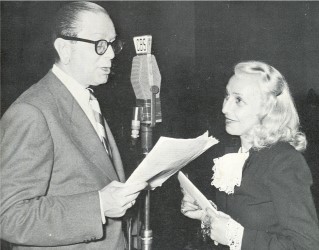 Jane and Goodman Ace star in four broadcasts of “Easy Aces,” one of the wittiest comedy programs ever to hit the airwaves. Written by Goodman Ace, the series was the ongoing saga of a long-suffering husband and his malaprop-prone wife, Jane -- a woman who had a voice that, to many, sounded like fingernails on a blackboard, but comic timing unmatched anywhere. Laden with hilarious malaprops - many of which, like “time wounds all heels” and “home wasn’t built in a day,” are still quoted to this day - “Easy Aces” brings us an hilarious glimpse of daily life among the middle classes; think of “Vic and Sade” in the big city and perhaps you’ll know what we mean.
Jane and Goodman Ace star in four broadcasts of “Easy Aces,” one of the wittiest comedy programs ever to hit the airwaves. Written by Goodman Ace, the series was the ongoing saga of a long-suffering husband and his malaprop-prone wife, Jane -- a woman who had a voice that, to many, sounded like fingernails on a blackboard, but comic timing unmatched anywhere. Laden with hilarious malaprops - many of which, like “time wounds all heels” and “home wasn’t built in a day,” are still quoted to this day - “Easy Aces” brings us an hilarious glimpse of daily life among the middle classes; think of “Vic and Sade” in the big city and perhaps you’ll know what we mean.
The series ran on various networks from 1931 thru 1945 and, after it ended, the savvy Goodman Ace revealed that he had not only retained the rights to the show, but also hundreds of recordings of the programs on high quality 16” transcriptions. Forming an agreement with the Frederick Ziv Company of Cincinnati, Ohio, long runs of the series were soon edited for syndication -- removing the original opening and closings of the shows, as well as the various commercials along the way. As a result, “Easy Aces” enjoyed a popular revival on local stations in the post-war years -- and many hundreds of shows are also available for listening today.
The four programs offered here were used as audition programs for the syndicated version of the show and, we believe, date from the late 1930s. In addition to Goodman and Jane Ace, the programs also feature Mary Hunter as Marge Stevenson, an old school chum of Jane’s who lived with the Aces for a time.
Audition - 222
Ace is surprised and upset to find that Jane’s brother, recently married to a wealthy young lady and newly back from his honeymoon, has charged two new $40.00 flannel suits with accessories to Ace’s account at a local department store.
15:00 - ZIV syndication
Audition - 749
Jane has been called for jury duty, so Ace and Marge vainly attempt to explain to her what will be expected from her as a potential juror.
15:00 - ZIV syndication
Audition - 750
In an episode featuring appearances by radio stalwarts Alan Reed and John Brown, Jane answers her summons and appears in court as a potential juror. Will American justice ever be the same again?
15:00 - ZIV syndication
Audition - 922
Jane writes a letter to her sister, thanking her for sending a book as a gift. Jane didn’t particularly enjoy the book - seems it was too “wishy-squishy” - and reminisces about the wonderful books she read as a young student.
15:00 - ZIV syndication
The Bob & Ray Show
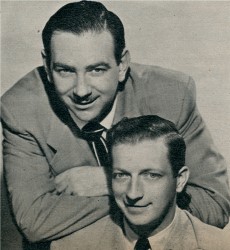 Following their years of success as a freewheeling comedy team on Boston’s 5000 watt WHDH, Bob Elliot and Ray Goulding found themselves offered a contract to appear in a five-a-week comedy series over the coast to coast NBC Radio Network. Packing up many of the characters that they had developed in Boston - including cooking show hostess Mary McGoon, rope trick artist Tex Blaisdell, and roving reporter Wally Ballou - the team moved to NBC in a 5:45-6:00 PM daily slot, attracted an increasingly appreciative audience, and eventually won a Peabody Award for excellence in broadcasting.
Following their years of success as a freewheeling comedy team on Boston’s 5000 watt WHDH, Bob Elliot and Ray Goulding found themselves offered a contract to appear in a five-a-week comedy series over the coast to coast NBC Radio Network. Packing up many of the characters that they had developed in Boston - including cooking show hostess Mary McGoon, rope trick artist Tex Blaisdell, and roving reporter Wally Ballou - the team moved to NBC in a 5:45-6:00 PM daily slot, attracted an increasingly appreciative audience, and eventually won a Peabody Award for excellence in broadcasting.
Over the years, many of Bob and Ray’s programs have survived - though often in edited form, offering only brief “skits” from various rebroadcasts over the years. The majority of the shows available today date from either their early days with WHDH or their later years on WOR and NPR. Programs from their first network series have proved elusive to locate -- but luckily, many of the programs were recorded by the Armed Forces Radio Service for rebroadcast to military personnel. Only slightly edited, the AFRS unwittingly preserved Bob and Ray in their prime -- and here we offer four 15-minute shows from this NBC daytime run, as rebroadcast by the AFRS. Starring Bob Elliot and Ray Goulding, these sustaining programs also feature “The Bob and Ray Orchestra,” a musical trio with Paul Taubman on the Hammond Organ, Sanford Gold on piano and Bill Bauer on guitar.
A Vacation at Lake Chipmunk (AFRS #17)
Mary McGoon complains that her Bob and Ray Surgeon Kit hasn’t yet arrived - and neither has her official Burglar Kit, either. Meantime, Windy Sturdley from the Lake Chipmunk Chamber of Commerce calls in to recommend a vacation in Maine and O. Leo Leahy makes a personal appearance to describe his unique profession. The “Bob and Ray Orchestra” perform “Tabu.”
Tuesday, August 7, 1951 - 15:00 - NBC/AFRS rebroadcast
The Bob and Ray Radio Script Writing School (AFRS #18)
Bob, Ray, and Mary McGoon discuss Steve Bosco’s latest attempt to publicize the show, the musicians perform a creative rendition of “I Got Rhythm,” and we enjoy another lesson in professional radio writing -- this time concerning essential plot points for crime shows.
Wednesday, August 8, 1951 - 15:00 - NBC/AFRS rebroadcast
Pretty Please (AFRS #97)
A particularly diverse program, in which we hear of baby opossums, ham, gas mains, and the life of a professional game show contestant -- plus “guess the tune” with disc jockey Corby Loftis, an on-air disc jockey audition with Tex Blaisdell, and the musical selection “A Kiss to Build a Dream On.”
Wednesday, December 12, 1951 - 15:00 - NBC/AFRS rebroadcast
The Tex and Mary McGoon Show (AFRS #98)
Another special offer from the Bob and Ray Overstocked Warehouse, an interview with a fisherman, a chat with Tex Blaisdell, a musical selection entitled “Dance Me Loose,” and a peek behind the scenes of the early morning breakfast time favorite “The Tex and Mary McGoon Show.”
Thursday, December 13, 1951 - 15:00 - NBC/AFRS rebroadcast
Nightbeat
In the postwar years, a new style of filmmaking began to emerge. Inspired in part by the moody and avant-garde expressionistic school that the Germans brought to the medium in the last days of the silent era, American mystery and detective films began adopting a dark and shadowy look, as well as an air of anxiety, pessimism, and suspicion in both plot and characterization. To critics, it became known as “film noir” -- literally “black film” or “black cinema” -- a style that would also quickly make its way to radio in such hard-bitten, downbeat series as “The Adventures of Philip Marlowe” and “Broadway’s My Beat.”
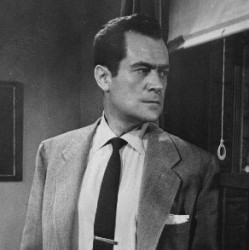
One of the top proponents of this style - and arguably the best of radio’s various newspaper-based dramas - was “Nightbeat,” the story of hard-nosed Chicago Star newsman Randy Stone and his quest for the human news behind the headlines. Starring Frank Lovejoy in the leading role, Stone came to vivid life thanks to expert scripts by experienced scribes like Russell Hughes (who would also write similar stories for “Box 13” and “Richard Diamond”), E. Jack Neumann, John Michael Hayes (who would later go on to write the Hitchcock film classics “To Catch a Thief” and “Rear Window”), and Larry Marcus. Lovejoy’s distinctive voice and manner, combined with performances by veteran radio performers like Lurene Tuttle, Peter Leeds, Jeff Corey, and Jerry Hausner, gave “Night Beat” an unusual and engrossing style. One week the story would be lighthearted and tongue-in-cheek, the next an emotional tragedy with a downbeat ending; there would be suspenseful races for time and quiet reflections on everyday life among the masses. Through it all, Randy Stone, in a hard-boiled yet sensitive portrayal by Frank Lovejoy, would narrate the story and comment on it from beginning to end -- often with a hard-edged cynicism that long-time fans knew was a cover for Stone’s personal sense of fairness and morality.
Though generally popular with listeners, “Nightbeat” spend most of its three-year run bouncing around the NBC schedule -- usually without a sponsor and sustained by the network. Fans of the series often complained that they didn’t know from week to week when - or if - it would be on. As a result, radio enthusiasts of today have probably heard more “Nightbeat” programs that most listeners heard when it was first broadcast over fifty years ago. The two programs offered here are typical but intriguing entries from the series, both taken from NBC reference recordings preserved to tape in the early 1970s.
The Telephone
After a misdial leads to a wrong number, Randy Stone decides to dial his phone at random -- and ends up speaking to a frightened woman who believes that her mentally ill husband is about to murder her. Frank Lovejoy stars in a program written by Larry Marcus and directed by Warren Lewis, with music composed and conducted by Frank Worth. Broadcasting from Hollywood, the cast includes Barbara Dupar, Jay Novello, Katherine Card, Lurene Tuttle, Peter Leeds, and announcer William Lally.
Monday, July 31, 1950 - 30:00 - NBC, sponsored by Wheaties
A Woman’s Tears
A criminal known as the Slasher is terrorizing Chicago, attacking fourteen women in the past three weeks. Randy Stone’s investigation quickly leads to a fellow named Rick Bennett -- an artist who trades sketches and murals for drinks and meals in local taverns. Bennett’s work is good, but slightly odd; seems that the drawings of all of his subjects are uniquely rendered...with scars on their faces. Frank Lovejoy stars in a program written by E. Jack Neumann and John Michael Hayes and produced and directed by Warren Lewis, with music by Frank Worth. Broadcasting from Hollywood, the cast includes Jeff Corey, Joan Banks, Sidney Miller, Nestor Paiva, Jerry Hausner, and Lou Krugman.
Friday, November 10, 1950 - 30:00 - NBC, sustaining
The James Melton Show (The Texaco Star Theater)
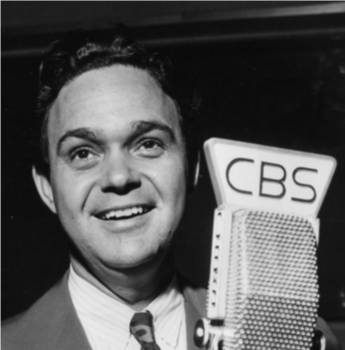
Tenor James Melton began his radio career in the earliest days of the networks, appearing as early as 1927 on NBC’s “The Palmolive Hour” as part of a popular musical quartet known as The Revelers. Quickly becoming known for his solo talent in performing both light opera and popular favorites, Melton appeared frequently on radio throughout the 1930s -- including stints as Jack Benny’s vocalist in 1933, Bob Hope’s featured tenor in his first radio series in 1935, and regular appearances on concert series such as “The Chicago Theater of the Air,” “The Palmolive Beauty Box Theater” with Gladys Swarthout and Jessica Dragonette, and “The Ford Summer Hour” on Sunday evenings with maestros Donald Voorhees and Meredith Willson.
In 1943, Melton - who was by now also the leading tenor of New York’s Metropolitan Opera company and a popular touring concert artist - was given the chance to host his own summer series, taking over the timeslot usually occupied by Fred Allen’s “Texaco Star Theater” comedy series on CBS. Featuring Allen’s orchestra leader Al Goodman at the podium (a perfect fit, as Goodman was also well known at the time for his recordings of light classical favorites) as well as English pianist and musical comedian Alec Templeton, Melton’s program became a favorite among listeners for its combination of popular melodies, well-known operatic classics, and the amusing performances and parodies performed by Templeton and Melton’s various guest artists. Melton returned for another summer run in 1944 - a series that unexpectedly continued into the fall when Allen was unable to return to his show due to health problems.
James Melton’s “Texaco Star Theater” series continued to be heard until the fall of 1946, when his increasing commitments to both the Metropolitan Opera and a heavy concert schedule required him to drop his weekly radio commitment. He would continue to be heard in guest appearances, as well as appear as the host of an early television variety series for Ford in 1950. He died suddenly in 1961 after suffering a bout of pneumonia, aged only 57 years of age.
Guests Alec Templeton and Rise Stevens (AFRS #42)
James Melton solos on “Begin the Beguine,” “I Got Plenty of Nothing,” and “Le Rêve de Manon” from Massenet’s opera “Manon,” mezzo-soprano Rise Stevens sings “Habanera” from Bizet’s opera “Carmen,” Alex Templeton performs his own version of Addinsell’s “Warsaw Concerto,” and Melton and Stevens duet on Sigmund Romberg’s “Close as Pages in a Book” from “Up in Central Park.” The program closes with a rousing musical salute to the United Nations featuring the entire cast and Al Goodman’s orchestra and chorus.
Sunday, April 15, 1945 - 30:00 - CBS/AFRS rebroadcast
Guests Anna Mary Dickie and Ed Wynn (AFRS #83)
James Melton opens the program with “I Will Bring You Music,” based on Rachmaninoff’s Piano Concerto No. 2 in C Minor, and also performs “Symphony” and Massenet’s “Elegy” with a violin obbligato by soloist Jules Schachter. Guest Ed Wynn, returning to his role as the Fire Chief on his own Texaco series of the early 1930s, gives his comedic commentary on the story of the opera “Faust.” From “Private Lives,” guest Anna Mary Dickie performs Noel Coward’s “Someday I’ll Find You” and, along with the Lyn Murray Male Chorus, performs “If I Loved You” from “Carousel.” The program concludes with a medley of familiar songs by Hungarian composer Emmerich Kalman. David Broekman conducts the orchestra.
Sunday, January 27, 1946 - 30:00 - CBS/AFRS rebroadcast
The Man on the Farm
Quick! Name one of the top ten network weekend shows from the early 1950s! Can’t do it? Well, we’re not surprised. Daytime radio in the weekday hours was dominated by highly-rated soap operas but, on the weekends, listeners turned to a different kind of programming - primarily religious broadcasts and agricultural shows. And, for many years, one of the top ten shows of the agricultural type was “The Man on the Farm.”
Throughout most of radio’s golden age, America was still a nation of small towns -- and many of these towns were supported by family farms, raising the crops and livestock necessary to sustain the nation. After almost a decade of deprivation and uncertainty, World War II finally brought an end to declining farm prices and, with this, came a period of prosperity previously unknown in these close-knit communities. As always, radio did its best to reflect the needs and interests of the nation -- and, for much of Middle America in the 1940s, the interest was in ways to increase production and cut prices for independent farmers, livestock ranchers, poultry men, dairy owners, and their related industries.
“The Man on the Farm,” sponsored by the Quaker Oats Company on behalf of its Ful-O-Pep line of animal feeds, began as a syndicated weekly feature in about 1942 and ran for well over a decade -- eventually making its way to the full Mutual Network in the early 1950s. Recorded at the Quaker Oats Experimental Farm near Libertyville, Illinois and hosted by a genial Oklahoman named Chuck Akery, the program offered a lighthearted Saturday afternoon combination of audience participation show features like those heard regularly on “The Breakfast Club” and “Welcome Travelers.” A small studio audience, consisting mostly of indomitable farm wives, were regularly asked to answer questions sent in by listeners as Akery moved through the crowd with a portable microphone -- perhaps winning a pound of feed or two for their trouble. Reggie Cross on the harmonica and legendary Hammond Organist Porter Heaps would perform musical duets, while Ful-O-Pep advised listeners on new ways to increase egg production and issued a weekly blue ribbon award to an outstanding farm or dairy. The show usually closed with an amusing contest, in which participants could win $1.00 to $5.00 just for coming before the microphone.
If you grew up in a small town, were raised on a farm, or ever belonged to a Grange organization, you’ll find “The Man on the Farm” a familiar and entertaining time capsule of rural life in the early postwar years. It’s also a reminder that radio, in its hey-day, was far more diverse than just the big-time network shows we remember today would lead us to believe. Is it corny? Maybe -- but down-to-earth and a great deal of fun, too.
Show #288
Audience discussions range from how cucumbers blossom to whether watermelons only turn red inside when they’re exposed to fresh air. The program concludes with a contest in which seven women compete to see who can give the best imitation of a howling tom cat.
Saturday, August 9, 1947 - 30:00 - Syndicated, sponsored by Quaker Oats Ful-O-Pep Feeds
Show #289
Can a chicken hatch and successfully raise a setting of peacock eggs? What is the difference between a chocolate cake and a devil’s food cake? Which would produce the most meat: a fat little pig or a little fat pig? All of these questions are addressed at length -- and the program concludes with a contest to see which little boy in the studio audience has the most items stored in his pockets.
Saturday, August 16, 1947 - 30:00 - Syndicated, sponsored by Quaker Oats Ful-O-Pep Feeds